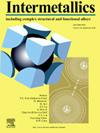Mechanochemical synthesis of Ni3Al nano-alloy
IF 4.8
2区 材料科学
Q2 CHEMISTRY, PHYSICAL
引用次数: 0
Abstract
The nickel aluminide nanoalloy was synthesized by chemical reduction of nickel(II) chloride hexahydrate salt by aluminum nanoparticles under basic (S1) and acidic (S2) conditions in the solid-state reaction. Aluminum nanoparticles were prepared by a novel wire drawing method in the presence of lubricating oil. Analysis of products (S1) and (S2) show that the prepared samples have different fraction component of compounds, morphologies, particle size and magnetic properties. The products were characterized by IR, XRD, FESEM, and VSM. The absorption bands do not appear in FTIR spectra of products (S1) and (S2) while, the spectra of precursors show all the absorption bands of nickel(II) chloride hexahydrate salt. The X-ray diffraction pattern results show the presence of three phases unreacted aluminum, metallic nickel and Ni3Al nano-alloy in products. The weight fraction of Ni3Al nanoparticles is calculated by the Rietveld method. Quantitative XRD analysis of (S1) shows a weight fraction of 33.90 % Ni3Al, 61.19 % metallic nickel and unreacted aluminum 4.90 % also, calculation in (S2) shows weight fraction Ni3Al, metallic nickel and unreacted aluminum 19.75, 77.83 and 2.42 % respectively. FESEM image of S1 and S2 show particles size distribution in the region 11–17 nm and 40–150 nm respectively. The hysteresis loop of S1 and S2 show magnetic saturation 7. 90 emu/g and 17.04 emu/g respectively.

Ni3Al纳米合金的机械化学合成
在碱性(S1)和酸性(S2)条件下,用铝纳米粒子对六水氯化镍盐进行化学还原,合成了镍铝纳米合金。在润滑油的存在下,采用新型拉丝法制备了铝纳米颗粒。对产物(S1)和(S2)的分析表明,制备的样品具有不同的化合物组分、形貌、粒度和磁性能。通过IR、XRD、FESEM和VSM对产物进行了表征。产物(S1)和(S2)的FTIR光谱中没有出现吸收带,而前驱体的光谱显示六水氯化镍盐的所有吸收带。x射线衍射结果表明,产物中存在三相未反应铝、金属镍和Ni3Al纳米合金。采用Rietveld法计算Ni3Al纳米颗粒的质量分数。(S1)的XRD定量分析表明,Ni3Al的质量分数为33.90%,金属镍为61.19%,未反应铝为4.90%;(S2)的计算表明,Ni3Al、金属镍和未反应铝的质量分数分别为19.75%、77.83和2.42%。S1和S2的FESEM图像分别显示了11-17 nm和40-150 nm区域的颗粒尺寸分布。S1和S2的磁滞回线表现为磁饱和。90 emu/g和17.04 emu/g。
本文章由计算机程序翻译,如有差异,请以英文原文为准。
求助全文
约1分钟内获得全文
求助全文
来源期刊

Intermetallics
工程技术-材料科学:综合
CiteScore
7.80
自引率
9.10%
发文量
291
审稿时长
37 days
期刊介绍:
This journal is a platform for publishing innovative research and overviews for advancing our understanding of the structure, property, and functionality of complex metallic alloys, including intermetallics, metallic glasses, and high entropy alloys.
The journal reports the science and engineering of metallic materials in the following aspects:
Theories and experiments which address the relationship between property and structure in all length scales.
Physical modeling and numerical simulations which provide a comprehensive understanding of experimental observations.
Stimulated methodologies to characterize the structure and chemistry of materials that correlate the properties.
Technological applications resulting from the understanding of property-structure relationship in materials.
Novel and cutting-edge results warranting rapid communication.
The journal also publishes special issues on selected topics and overviews by invitation only.
 求助内容:
求助内容: 应助结果提醒方式:
应助结果提醒方式:


